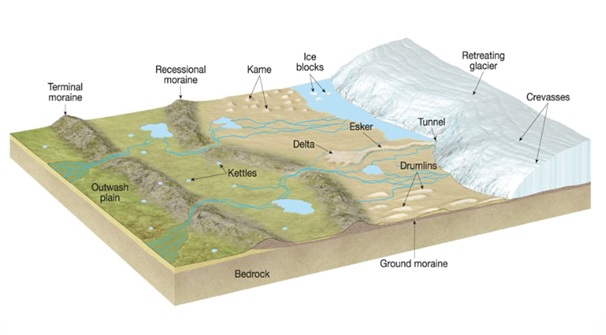

14th February 2022 (6 Topics)
Context
About
About Glaciers:
- A glacier is a large, perennial accumulation of crystalline ice, snow, rock, sediment, and water that originates on land and moves down slope under the influence of its own weight and gravity. They are sensitive indicators of changing climate.
- Out of total water on Earth, 2.1% is in glaciers while 97.2% is in the oceans and inland seas.
- Condition of glacier formation:
- Mean annual temperatures are close to the freezing point.
- Winter precipitation produces significant accumulations of snow.
- Temperatures throughout the rest of the year do not result in the complete loss of the previous winter’s snow accumulation.
Glacial Landforms:
Glaciers have played a prominent role in the shaping of landscapes in the mid and high latitudes of alpine environments. The major landforms made by glaciers are:
|
Glacial Erosional Landforms |
Glacial Depositional Landforms |
|
The major erosional landforms made by glaciers are:
|
The major depositional landforms made by glaciers are:
|

Why in news?
- Ministry of Earth Science in a reply in lok Sabha said that, Glaciers in the Karakoram region are in a stable condition, but those feeding the Ganga and the Brahmaputra river basins are melting at a faster rate.
- The ministry, through its autonomous institute National Centre for Polar and Ocean Research (NCPOR), has been monitoring glaciers in the Chandra basin (2,437 square kilometre area) in western Himalaya since 2013.
About NCPOR:
- The National Centre for Polar and Ocean Research (NCPOR) was established as an autonomous Research and Development Institution of the Ministry of Earth Sciences.
- The mandate of NCPOR is multi-dimensional:
- Leadership role in niche areas of scientific research in the domain of polar and ocean sciences.
- Lead role in the geoscientific surveys of the country’s EEZ and its extended continental shelf beyond 200M, deep-sea drilling in the Arabian Sea basin through the IODP, exploration for ocean non-living resources such as the gas hydrates and multi-metal sulphides in mid-ocean ridges.
- Facilitatory role in the scientific research activities being undertaken by several national institutions and organizations in Antarctica, the Arctic and in the Indian Ocean sector of the Southern Ocean.
- Management role in implementing all scientific and logistics activities related to the Annual Indian Expeditions to the Antarctic, Arctic and Southern Ocean.
- Management and upkeep of the Indian Antarctic Research Bases “Maitri” and “Bharati”, and the Indian Arctic base “Himadri”
- NCAOR has adopted seven major glaciers of Chandra basin to monitor for long term integrated glaciological studies and established one base station at Sutri Dhaka for operational requirements. These seven glaciers are:
- Bara Shigri (136 sq km)
- Samudra Tapu (98 sq km)
- Sutri Dhaka (25.4 sq km)
- Batal (4.92 sq km)
- Nalka Nal (98 sq km)
- Gepang (98 sq km)
- Kungum (98 sq km)

